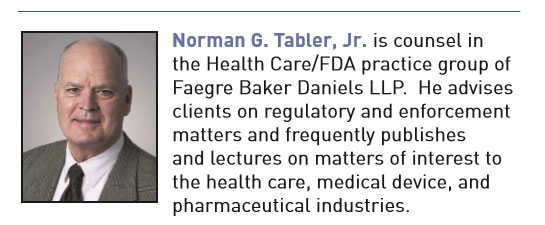
FDCA Conviction without Evidence of Knowledge or Intent?
by Norman G. Tabler, Jr.
In January 2016 the Eighth Circuit Court of Appeals affirmed the misdemeanor conviction of a store clerk for violating the Food Drug & Cosmetics Act (FDCA)1 by selling misbranded synthetic drugs to undercover government agents. In rejecting the clerk’s appeal, the court stated that “neither knowledge nor intent is required” for a misdemeanor violation of § 331. The mere fact of assisting in the sale of misbranded drugs—serving as the clerk who handled the sale—was sufficient.2 If that means that a person can be convicted without knowledge that the drugs were misbranded or intent to sell misbranded drugs, it is a troubling principle.
Background
James Carlson owned and operated the Last Place on Earth store in Duluth, Minnesota. The store sold synthetic drugs3 and was, in the words of the Eighth Circuit, a “head shop”—that is, a retail outlet specializing in paraphernalia used for the consumption of marijuana and marijuana-related products. Carlson’s domestic partner, Lava Haugen, and his son, Joseph Gellerman, worked in the store as clerks. Haugen and Gellerman handled the receipt of drugs from suppliers and the sale of drugs to customers. Haugen also weighed and bagged synthetic drugs, assisted in ordering them from suppliers, and took inventory.4
The drugs in question were synthetic drugs that had arrived through interstate commerce. They were labeled “not for human consumption,” but the defendants knew that customers intended to consume them, usually by smoking them.5
Between August 10, 2011, and September 21, 2012, undercover law enforcement agents bought 75 synthetic drug products at the Last Place on Earth. Gellerman was the sales clerk who handled six of the sales. One of those purchases contained a trace amount of the controlled substance JWH-018, a synthetic cannabinoid.6
Trial Proceedings
The government brought criminal charges against owner James Carlson and store clerks Lava Haugen and Joseph Gellerman. All three were charged with violating the FDCA, the Controlled Substances Act (CSA),7 and the Controlled Substance Analogue Enforcement Act of 1986 (Analogue Act)8 by selling misbranded synthetic drugs at the Last Place on Earth.
At the trial, witnesses including the law enforcement agents who had purchased the drugs, testified that Haugen prepared order forms for Carlson, who then ordered the drugs by telephone in the presence of Haugen. A former employee testified that when the government scheduled a substance, Carlson moved drugs containing that substance to the store basement and later sold them under the counter to customers he regarded as trustworthy.9
The jury found owner Carlson guilty of conspiracy to violate the FDCA, nine felony violations of the FDCA, one violation of the CSA, conspiracy to violate the Analogue Act, and 23 money laundering violations under 18 U.S.C. § 1957.10
Haugen was convicted of conspiracy to violate the FDCA, two felony violations of the FDCA, and conspiracy to violate the Analogue Act.11
Gellerman was charged with aiding and abetting delivery of misbranded drugs received in interstate commerce in violation of 18 U.S.C. § 2 (aiding or abetting an offense) and 21 U.S.C. §§ 331(c) (delivery of a misbranded product), 333(a)(2) (violation of the FDCA with intent to defraud or mislead), 352(a) (false or misleading label), 352(b) (package and contents of label), and 352(f) (directions on label). He was convicted of misdemeanors on two counts, delivery of misbranded drugs without intent to defraud. He was sentenced to three years probation and 90 days of home electronic monitoring and ordered to pay a $50 special assessment and a $1,000 fine.12
Gellerman’s Appeal
Gellerman appealed his two misdemeanor convictions. He argued that unlike Carlson, he was not an owner of the Last Place on Earth. He was not an officer or even a manager. Unlike Haugen, he was not involved in ordering the products and had no access to the chemical charts that Carlson and Haugen had seen, which showed the molecular formulas of the products they sold. In the words of the appellate court, Gellerman “had limited responsibilities as a store clerk.”13 He was acting in that capacity when he performed the acts that resulted in the charges against him: handling the sale of drugs to undercover government agents.
Jury Instructions
In his appeal Gellerman argued that the trial court erred by instructing the jury that it could find him guilty of the misbranding offense without intent to defraud the government, provided that it found that all the other elements of a FDCA violation were proved.
Gellerman was handicapped in his appeal. He had not objected to the lower court’s jury instructions when they were given. Therefore, the appellate court was obligated to apply a “plain error” standard of review and to view the evidence in the light most favorable to the verdict.14
The jury had been instructed that it could convict even though a defendant had no intent to defraud the government, provided that all other elements of an FDCA offense were present. That was a test Gellerman was bound to fail because the only element necessary for the misbranding offense was assistance in the sale of the product. He had clearly assisted in the sale. After all, he was the clerk who handled the sale.
In rejecting Gellerman’s challenge to the instructions, the court cited the Eighth Circuit’s decision in United States v. Hiland for the proposition that “neither knowledge nor intent is required for a misdemeanor violation of § 331.”15
Sufficiency of the Evidence
After disposing of Gellerman’s challenge to the jury instructions, the court turned to the sufficiency of the evidence. It began by observing that the issue is reviewed de novo, viewing all the facts in the light most favorable to the verdict.16
Then, citing United States v. Dotterweich,17 the court noted that because misbranding is a strict liability offense, the government need only prove that Gellerman was “responsible for, or aided and abetted in the commission of, delivering” the drugs.18 The government was not required to prove knowledge or intent.
The court also cited the United States Supreme Court decision in United States v. Park19 for the proposition that “misdemeanor liability stems not from ‘corporate hierarchy,’ but from an individual’s role in the sale of misbranded drugs.”20 In the court’s view, Gellerman had certainly had a “role” in delivering the drugs and therefore could be convicted without proof of knowledge or intent.
Turning the Corporate Ladder Upside Down
In rejecting Gellerman’s challenge to the jury instructions and the evidence, the Eighth Circuit relied on Hiland, Dotterweich, and Park for the proposition that neither actual knowledge nor intent is necessary for a misdemeanor conviction under the FDCA. Those three cases do, in fact, express that principle. Yet even a quick reading of the three decisions reveals that they are not at all applicable to Gellerman’s situation.
United States v. Hiland
Hiland involved the manufacture and distribution of the intravenous drug E-Ferol Aqueous Solution (E-Ferol), purported to combat retrolental fibroplasia (RLF), a disease that causes impaired vision or blindness in premature infants. The defendants were the president of the corporation that manufactured the drug and the president of the corporation that distributed it. They knew that the drug had not been approved by FDA and that it posed a grave danger of harm or death to infants. They labeled the drug as a vitamin E supplement while by other means advising physicians that it was meant for RLF treatment. The scheme resulted in grave injury to some infants and death to others.
The two corporate presidents were convicted under 21 U.S.C. § 333(a)(2), a felony requiring intent. On appeal, they challenged the trial court’s refusal to instruct the jury that (1) knowledge that E-Ferol was an unapproved “new drug” was an essential element of the “new drug” offense and (2) knowledge that E-Ferol was “misbranded” was an essential element of the misbranding offense. Instead, the trial court had instructed the jury that the essential elements of the new drug offense were that (1) the defendants introduced E-Ferol into interstate commerce, (2) E-Ferol was an unapproved new drug, and (3) the defendants acted with the intent to defraud or mislead. The instruction on the misbranding offense was the same, with the term “misbranded” substituted for “unapproved new drug.”
The Hiland court used § 331—the misdemeanor for which Gellerman was convicted—as the first step in a two-step analysis of the defendants’ challenge to their § 333 felony convictions. The court began by observing that “under Sec. 333(a)(1), neither knowledge nor intent is required for a misdemeanor violation of § 331.” It then noted that “the only additional element required by Sec. 333(a)(2) for a felony violation is ‘the intent to defraud or mislead.’” 21 It concluded the analysis—and rejection of the defendants’ challenge—by ruling that the jury had had ample evidence proving the necessary intent to defraud or mislead.
Therefore, the Hiland court did not even have a misdemeanor conviction before it when it made the statement quoted in Gellerman’s case. It was addressing § 333(a)(2) felony convictions. The defendants were corporate presidents—not store clerks. The product in question was an unapproved and intentionally misbranded injectable drug that endangered infants—not mislabeled synthetic cannabis. And the product injured some infants and killed others.
United States v. Park
When the Hiland court stated that “neither knowledge nor intent is required for a misdemeanor violation in § 331”—the statement quoted in Gellerman—it cited a single authority, the U.S. Supreme Court decision in United States v. Park.22The citation was appropriate to the Hiland appeal because Park, too, addressed the conviction of a high corporate executive—the president of a “large, national food chain.” He was appealing his FDCA conviction arising out of the chain’s distribution of rodent-contaminated food. He argued that he could not be convicted absent proof of his actual knowledge of the contamination. His argument was, in effect, that he was too high up the corporate ladder to have personal knowledge of rodent droppings.
That was the context in which the Park court ruled that actual personal knowledge was unnecessary for conviction. The point was that a corporate officer with the authority and responsibility for causing or preventing an illegal act or omission could be convicted without proof of his own actual knowledge of the details of the illegal action or omission.
The president could be convicted without proof of actual knowledge because by virtue of his “managerial position,” he “could be deemed responsible” even though the specific act or omission in question was or should have been performed by a lower level employee.23 But nothing in Park indicates that the lower level employee could be convicted without proof of actual knowledge or intent to violate the law.
United States v. Dotterweich
Park relies heavily—almost exclusively—on United States v. Dotterweich for the ruling in question. That case, too, concerned a large corporation’s highest officer. He was convicted because his corporation had shipped misbranded drugs in interstate commerce. In upholding the conviction, the Supreme Court stated the purpose of the FDCA in the following terms:
Such legislation dispenses with the conventional requirement for criminal conduct—awareness of some wrongdoing. “In the interest of the larger good, it puts the burden of acting at hazard upon a person otherwise innocent but standing in responsible relation to a public danger.”24
The corporate president could be convicted without evidence of his actual knowledge that the corporation shipped misbranded drugs, because of his authority and responsibility for the corporation’s actions. But that does not mean that the shipping clerk could be convicted in the absence of evidence that he knew that he was shipping misbranded drugs. The fact that a corporate president has responsibility for a clerk’s actions does not mean that the clerk has responsibility for the president’s actions.
Yet that is what the Eighth Circuit in effect said about Joseph Gellerman. The opinion gives the impression that the mere fact of selling the product—without evidence that Gellerman knew that it was misbranded or intended to sell a misbranded drug—means that he can be convicted under § 331. By that standard a great many of the employees of the corporations in Hiland, Park, and Dotterweich could be convicted despite their lack of knowledge or intent. The only test would be whether their employment duties involved or contributed to the delivery or sale of the products.
The Right Outcome for the Wrong Reasons?
The decision against Joseph Gellerman employs language that states without qualification that a person may be convicted of aiding or abetting in the delivery of misbranded drugs despite lack of knowledge of the misbranding or intent to deliver misbranded drugs. If that is so, then at any given moment innocent shipping, receiving, and sales personnel—not to mention postal and delivery personnel—all over the country are at risk of prosecution for aiding in the delivery of misbranded drugs, even though they have no knowledge of the misbranding. Surely that cannot be the intent of the statute.
But the outcome of the case—Gellerman’s misdemeanor conviction—may very well have been correct because there was, in fact, ample evidence that he had both knowledge of the misbranding and intent to sell misbranded products. That is apparent in the appeal briefs of both Gellerman and the government.
Gellerman’s Knowledge
The government’s appellee’s brief noted, without contradiction by Gellerman in either his appellant’s brief or his reply brief, that he had testified before the Duluth City Council that JWH-018 should remain legal and that he had telephoned FDA and received confirmation that the substance was not approved for human consumption.25
The government brief also pointed out, again without contradiction by Gellerman, that the evidence included Gellerman’s repeated statements to customers, documented by both audio and video recordings, on how to smoke the products marked “not for human consumption,” the pharmacological effects of smoking them, and whether they could be detected by urine test.26
Gellerman’s appeal briefs did not deny the government’s version of the evidence. Rather, they expressed the position that Gellerman lacked the “requisite responsibility or authority” to incur criminal liability.27 The argument was that the manufacturer of the products was responsible for its labeling and for the misleading statements on the labels, and that the store owner—not a “mere clerk”—was the true “seller” of the products.
As to the issue of whether “knowledge” is a requisite element of guilt, Gellerman’s argument was not that he lacked knowledge that the products were misbranded. His argument was that he lacked knowledge of the meaning of the legal term “misbranded” as used in the FDCA. He argued that the trial court declined to instruct the jury that they could not convict him unless they found that he knew the meaning of the term “misbranded” as defined in the statute.28 That is a far cry from arguing that he did not know that he was selling misbranded products.
The Eighth Circuit responded to Gellerman’s challenge to the jury instructions by ruling that “neither knowledge nor intent is required” for a misdemeanor violation of § 331.”29 But that is an answer to a question that had not been asked. The question that had been asked was much narrower: Is knowledge of the definition of the statutory term “misbranded” in the FDCA required for a misdemeanor conviction?
The court responded to Gellerman’s challenge to the sufficiency of the evidence by citing Dotterweich, which, as discussed above, held that a corporate president may be liable for a misbranding misdemeanor even in the absence of “awareness of wrongdoing.” But that, too, answers a question that had not been asked. There was clear evidence that Gellerman had an “awareness of wrongdoing”—an awareness that he was assisting in the sale of misbranded drugs. His position was that as a mere clerk, he lacked the authority to be found guilty—not that he lacked an awareness of wrongdoing.
Gellerman’s Intent
The Eighth Circuit’s treatment of Gellerman’s “intent” argument was the same as its treatment of his “knowledge” argument. In both cases the court overstated Gellerman’s argument and therefore expressed its ruling in overly broad terms. In addressing Gellerman’s “intent” argument, the court invoked Hiland as authority for the proposition that “neither knowledge nor intent is required” for a misdemeanor conviction under § 331. But Gellerman did not claim that he had no intent to sell misbranded drugs. His claim was that he had no intent to defraud the government. The jury instruction that he challenged was not the instruction that he could be convicted even if he did not intend to sell misbranded drugs.30 That instruction would have done him no good because there was ample evidence that he did intend to sell misbranded drugs.
The instruction that he challenged was the instruction that he could be convicted even if he did not intend to defraud the government. Presumably, his theory was that because the government agents knew that the drugs were misbranded, they could not be defrauded. So in his appeal, he was arguing that in order to be convicted, a defendant must not only intend to sell misbranded drugs, but must also intend to defraud the purchaser. By that standard, no one at the Last Place on Earth could be convicted of distributing misbranded drugs, because all the customers knew that they were buying misbranded products.
Therefore, when the court ruled that no intent was required for a misdemeanor conviction under § 331, it was answering a much broader—and much different—question than the one before it. It could have disposed of the question before it simply by saying that specific intent to defraud the buyer is not required for a misdemeanor conviction.
Impact of the Gellerman Opinion
The Gellerman opinion was filed on January 14, 2016. It is too early to predict its impact on future prosecutions under the FDCA, but it is not too early for the decision to raise concerns. On its face, the opinion appears to announce unreservedly that a sales clerk may be convicted of a misdemeanor misbranding violation without evidence that the clerk knew that the drugs were misbranded or intended to sell a misbranded product.
As discussed above, though, the record shows that Gellerman did know that the drugs were misbranded and did intend to sell misbranded drugs. He never claimed that he lacked that knowledge or intent. What he claimed was that he lacked the authority and responsibility necessary for conviction and that conviction required proof that he knew the statutory definition of “misbranding” and that he intended to defraud the buyer.
Gellerman’s arguments were narrow—even carping. The appeals court could have disposed of them with equally narrow language. But the court in effect chose to shoot down Gellerman’s arguments with a shotgun rather than a rifle. In relying on Hiland, the court borrowed a legal principle that was clearly meant for corporate officers at the highest level and applied it to a clerk at the lowest level.
The result is an opinion that on the surface appears to announce a frighteningly broad principle that allows criminal liability without knowledge or intent on the part of the accused.
- 21 U.S.C. § 331.
- U.S. v. Carlson, ___ F.3d ___, 2016 WL 158036 (8th Cir. 2016).
- “Synthetic cannabinoids, commonly known as ‘synthetic marijuana,’ ‘K2’ or ‘Spice’ are often sold in legal retail outlets as ‘herbal incense’ or ‘potpourri,’ and synthetic cathinones are often sold as ‘bath salts’ or ‘jewelry cleaner.’ They are labeled ‘not for human consumption’ to mask their intended purpose and avoid Food and Drug Administration (FDA) regulatory oversight of the manufacturing process.” https://www.whitehouse.gov/ondcp/ondcp-fact-sheets/.
- Id. at *1.
- Id.
- Id.
- 21 U.S.C. § 841.
- 21 U.S.C. § 813.
- U.S. v. Carlson, at *1.
- Id. at *2.
- Id.
- Id. and Brief of Appellant Gellerman, 2015 WL 512647, at *10, U.S. v. Carlson.
- U.S. v. Carlson, at *7.
- Id., citing U.S. v. Poitra, 648 F.3d 884, 887 (8th Cir. 2011).
- 909 F.2d 1114, at 1127 (8th Cir. 2011).
- U.S. v. Carlson, at *7.
- 320 U.S. 277 (1943).
- Id. at 12.
- 421 U.S. 658 (1975).
- Id.
- Note 15, supra (emphasis added).
- 421 U.S. 658 (1975).
- Id. at 670.
- Note 17, supra at 281, citing U.S. v. Balint, 258 U. S. 250 (1922).
- Brief of Appellee, 2015 WL 2147937 at *14, U.S. v. Carlson.
- Id. at 18.
- Brief of Appellant Gellerman, 2015 WL 512647 at *51, U.S. v. Carlson.
- Id.
- U.S. v. Carlson, at 12.
- U.S. v. Carlson at *7 and Brief of Appellant Gellerman at *53, U.S. v. Carlson.
Update Magazine
November/December 2016










